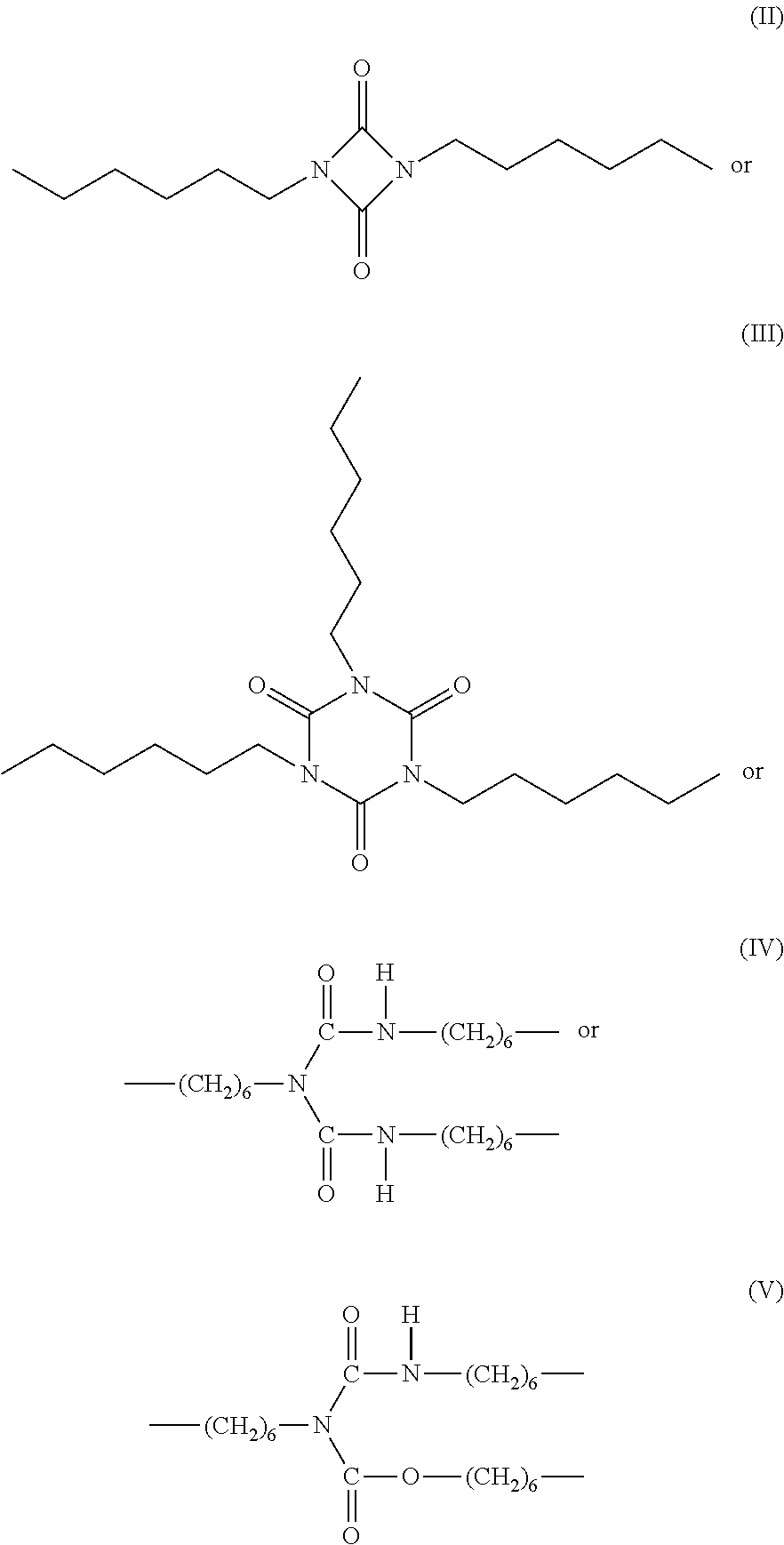Compound for manufacturing watermark in a textile sheet material and the corresponding composition, material, method and use
a technology of textile sheets and watermarks, applied in the direction of coatings, printing processes, applications, etc., can solve the problems of plurality of phase changes, dispersion, and intransparency of sheet materials as a whole, and achieve the effects of adjusting the refractive index, reducing the refractive index, and great transparency
- Summary
- Abstract
- Description
- Claims
- Application Information
AI Technical Summary
Benefits of technology
Problems solved by technology
Method used
Image
Examples
example 1
[0044]200.01 g (0.346 moles) of Desmodur® N 3400 and 90.11 g (0.692 moles) of octyl alcohol with an NCO:OH ratio of 3:2 are loaded and are left to react for approximately four hours in an inert nitrogen atmosphere at a temperature of 70° C. Desmodur® N 3400 is a mixture of hexamethylene diisocyanate trimer and hexamethylene diisocyanate dimer marketed by Bayer MaterialScience AG. The titrated NCO was 5.311% (NCOthecretical: 5.010%). 10% dried toluene (32.27g) is then added for fluidizing the pre-polymer. The temperature is finally lowered to 25° C. and all the free NCO is covered with 81.19 g of AMEO (0.367 moles) (21.87% silane out of the total solids); the silane is added together with another 10% dried toluene, yielding an end product with a content of 80% solids. An aminopropyltriethoxysilane which is marketed by EVONIK INDUSTRIES AG under the name Dynasylan AMEO, and also by Wacker Chemie AG under the name Geniosil GF 93 has been called “AMEO”. Generally, Desmodur N 3400 can be...
example 2
[0045]197.28 g (0.341 moles) of Desmodur N 3400 and 89.10 g (0.684 moles) of octyl alcohol with an NCO:OH ratio of 3:2 are loaded and are left to react for approximately three hours in an inert nitrogen atmosphere. The reaction temperature is 85° C. The titrated NCO was 4.973% (NCOtheoretical: 4.982%). The temperature is then lowered to 25° C. and 10% dried toluene (31.43 g) is added for fluidizing the pre-polymer. All the free NCO is then covered with 83.23 g (0.339 moles) of Geniosil 924 (22.52% silane out of the total solids); the silane is added together with another 10% dried toluene, yielding an end product with a content of 80% solids. Geniosil® XL 924 is an N-cyclohexylaminomethylmethyldiethoxysilane (CAS No. 27445-54-1) marketed by Wacker Chemie AG.
example 3
[0046]125.53 g (0.217 moles) of Desmodur N 3400 and 56.59 g (0.434 moles) of octyl alcohol with an NCO:OH ratio of 3:2 are loaded and left to react for approximately three hours in an inert nitrogen atmosphere. The reaction temperature is 85° C. The titrated NCO was of 4.922% (NCOthecretical: 5.003%). The temperature is then lowered to 70° C. and 10% dried toluene (20.24 g) is added for fluidizing the pre-polymer. All the free NCO is finally covered with 26.20 g (0.107 moles) of Geniosil 924 (12.57% silane out of the total solids) and with 23.66 g (0.107 moles) of AMEO (11.48% silane out of the total solids); the silanes are also added with dried toluene, yielding an end product with a content of approximately 85% solids.
PUM
| Property | Measurement | Unit |
|---|---|---|
| Temperature | aaaaa | aaaaa |
| Fraction | aaaaa | aaaaa |
| Fraction | aaaaa | aaaaa |
Abstract
Description
Claims
Application Information
 Login to View More
Login to View More - R&D
- Intellectual Property
- Life Sciences
- Materials
- Tech Scout
- Unparalleled Data Quality
- Higher Quality Content
- 60% Fewer Hallucinations
Browse by: Latest US Patents, China's latest patents, Technical Efficacy Thesaurus, Application Domain, Technology Topic, Popular Technical Reports.
© 2025 PatSnap. All rights reserved.Legal|Privacy policy|Modern Slavery Act Transparency Statement|Sitemap|About US| Contact US: help@patsnap.com



